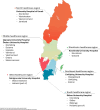The healthcare system in Sweden
- PMID: 40383868
- PMCID: PMC12170770
- DOI: 10.1007/s10654-025-01226-9
The healthcare system in Sweden
Abstract
The Swedish population is characterized by high life expectancy and low avoidable mortality rates. This review outlines the Swedish healthcare system, which offers universal access to all residents and has a long tradition of reforms for social equity. Responsibility for healthcare is shared between the state, the regions, and the municipalities. The Ministry of Health and Social Affairs provides the overall healthcare framework; additionally, several governmental agencies are directly involved in healthcare and public health initiatives. The 21 regions organize, finance, and provide most primary, secondary, and tertiary care, as well as health information channels. Resources for primary care are less plentiful than in many other countries. The 290 municipalities deliver care to elderly people and those with functional impairment. The Swedish healthcare system is primarily tax-funded, with 86% of total healthcare expenditures from public expenses and < 1% from voluntary health insurance. The gross domestic product (GDP) share of healthcare expenditures, 10.5% in 2022, is above the EU average. The level of unmet needs in the population is low, due to universal coverage and caps on user charges except for dental care. Sweden's healthcare system performs well on care quality and patient satisfaction, but suffers from workforce shortage and care fragmentation. Limitations in care coordination can be attributed to a siloed digital infrastructure and care governance, a low number of hospital beds per capita, and a compensation system that often does not incentivize coordination. Despite these challenges, life expectancy is high and avoidable mortality rates are low in Sweden.
Keywords: Epidemiology; Health care; Public Health; Sweden; Swedish.
© 2025. The Author(s).
Conflict of interest statement
Declarations. Competing interests: Dr Sundström reports direct or indirect stock ownership in companies (Anagram kommunikation AB, Sence Research AB, Symptoms Europe AB, MinForskning AB) and services to companies and authorities in the health sector, including Amgen, AstraZeneca, Bayer, Boehringer, Eli Lilly, Gilead, GSK, Göteborg University, Itrim, Ipsen, Janssen, Karolinska Institutet, LIF, Linköping University, Novo Nordisk, Parexel, Pfizer, Region Stockholm, Region Uppsala, Sanofi, STRAMA, Takeda, TLV, Uppsala University, Vifor Pharma, and WeMind..
Figures



Similar articles
-
North Macedonia: Health System Review.Health Syst Transit. 2024 Dec;26(6):1-164. Health Syst Transit. 2024. PMID: 40386870 Review.
-
Surveillance for Violent Deaths - National Violent Death Reporting System, 50 States, the District of Columbia, and Puerto Rico, 2022.MMWR Surveill Summ. 2025 Jun 12;74(5):1-42. doi: 10.15585/mmwr.ss7405a1. MMWR Surveill Summ. 2025. PMID: 40493548 Free PMC article.
-
Assessing the comparative effects of interventions in COPD: a tutorial on network meta-analysis for clinicians.Respir Res. 2024 Dec 21;25(1):438. doi: 10.1186/s12931-024-03056-x. Respir Res. 2024. PMID: 39709425 Free PMC article. Review.
-
Introducing the dataset for measuring centrality for sustainability-A case study of Pecinci municipality, Serbia.Data Brief. 2025 May 27;61:111714. doi: 10.1016/j.dib.2025.111714. eCollection 2025 Aug. Data Brief. 2025. PMID: 40534919 Free PMC article.
-
Molecular feature-based classification of retroperitoneal liposarcoma: a prospective cohort study.Elife. 2025 May 23;14:RP100887. doi: 10.7554/eLife.100887. Elife. 2025. PMID: 40407808 Free PMC article.
Cited by
-
Disease accumulation and distribution across the lifespan in Swedish centenarians and non-centenarians: a nationwide life course comparison of longevity and health resilience.EClinicalMedicine. 2025 Aug 2;87:103396. doi: 10.1016/j.eclinm.2025.103396. eCollection 2025 Sep. EClinicalMedicine. 2025. PMID: 40808965 Free PMC article.
-
Socioeconomic disparities in incidence, treatment, and survival of intrahepatic cholangiocarcinoma: insights from a nationwide cohort study in Sweden.Lancet Reg Health Eur. 2025 Aug 5;57:101415. doi: 10.1016/j.lanepe.2025.101415. eCollection 2025 Oct. Lancet Reg Health Eur. 2025. PMID: 40809904 Free PMC article.
References
-
- Statistikmyndigheten SCB, [Statistics Sweden]. Population 1 November by region, age and sex. Year 2002–2023 [Internet]. Accessed 22 October 2024. https://www.statistikdatabasen.scb.se/pxweb/en/ssd/START__BE__BE0101__BE....
-
- Landqvist M, Spetz J. Ten years with the Swedish Language act. Curr Issues Lang Plann. 2020;21(5):532–47. 10.1080/14664208.2020.1785752.
-
- The Organization for Economic Cooperation and Development/European Observatory on Health Systems and Policies. OECD Economic Surveys: Sweden, 2023.
-
- The Organization for Economic Cooperation and Development/European Commission. Health at a glance: Europe 2024: state of health in the EU cycle, OECD Publishing, Paris. 10.1787/b3704e14-en.
Publication types
MeSH terms
LinkOut - more resources
Full Text Sources
Medical
Miscellaneous

